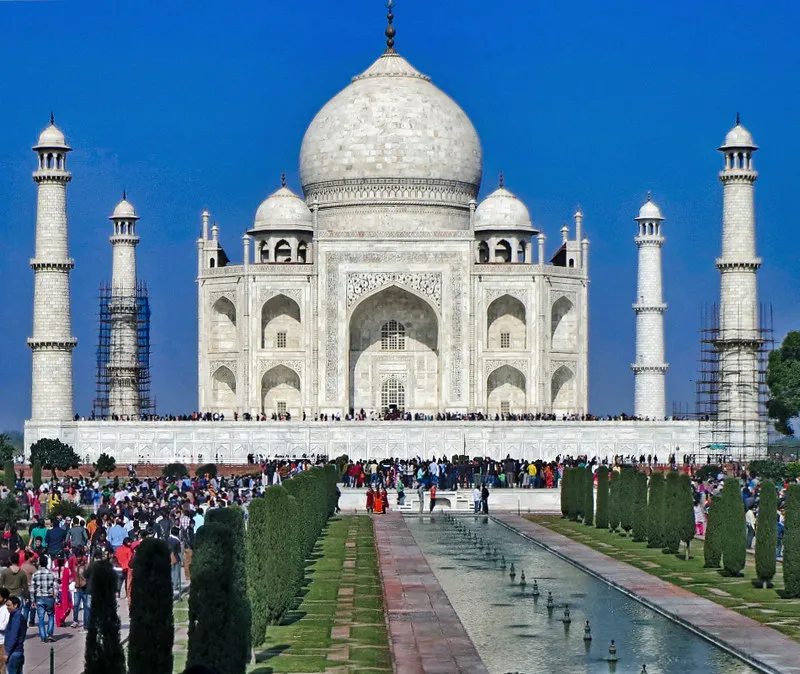In the city of Agra, where history meets dream, the Taj Mahal stands like a poem carved in white marble, composed by an emperor who loved his wife so deeply that he turned his grief into the greatest memorial of love humanity has ever known.
It is neither silent stone nor ordinary palace, but a beating heart telling the world that true passion can triumph over death, and that the memory of a beloved may live forever in the conscience of humankind.
Shah Jahan wished his wife’s tomb, Mumtaz Mahal, to be a mirror of their shared eternity. He built an edifice that breathes beauty, changing its colors with the passing hours, like the face of a lover lit by joy or veiled with sorrow. Thus, the Taj Mahal became an icon of immortal love, an eternal message that hearts in love can write with art what swords fail to inscribe with might.
The Taj Mahal is not cold stone nor mute structure, but a soul embodied in white marble, a being that inhales light and alters its visage with the turning of the sun:
At dawn, it blushes shyly like a tender flower.
At noon, it gleams in radiant whiteness, pure and serene.
At sunset, it wears golden warmth, echoing the fire of passion.
And under moonlit nights, it shines as though it holds an entire moon within its heart.
The choice of white marble was no coincidence; it was the color dearest to Mumtaz Mahal’s heart, the purest canvas for the embrace of light and shadow—so that the mausoleum became an eternal painting renewed with every moment of the day.

The Symmetry that Bewilders the Eyes
Once you cross the great gates, the magic of absolute symmetry crafted by the genius of Mughal architecture takes you; Every dome has a twin, every minaret has a sister, and every inscription finds an echo like it on the opposite side, until the scene is completed in harmony that challenges both the eye and the mind.
The Great Dome, 35 metres in diameter, rises like a heavenly throne. Four graceful minarets surround the building as loyal guards, tilted slightly outward to protect the palace in the event of an earthquake.
The “Sharbagh” water gardens embrace the palace with four axes inspired by the image of heaven, and at its heart is “Bahr Al-Kawthar”, which reflects the shrine in the water as if it doubles its presence between earth and sky.
As for the ornaments, inlaid with precious stones, they are flowers that never wither, scattered among Qur’anic verses inscribed in Thuluth and Kufic scripts—like a luminous cloak guarding the palace.
Architect George Michell once said: “The harmony of the Taj Mahal is not only limited on stone and geometry, but extends to light and shadow, creating a scene that changes at every moment, but never loses its perfection.” “
An Epic of Hands and Souls
This beauty was not born of emptiness, but of the sweat of thousands of hands and the creativity of thousands of souls:
- 500 carvers from Bukhara.
- 150 calligraphers from Syria and Persia.
- 2000 artisans of ornamentation from South India.
- 1500 stoneworkers from Baluchistan.
- More than 1,000 elephants contributed to carrying the heavy stones.

It was a cross-border and cross-cultural project, in which the civilizations of India, Persia, the Arabs and Turkey met in one crucible, bringing to the world the Taj Mahal: a masterpiece that speaks all the languages of love.
The Crown Between Past and Present
Today, after four centuries, the Taj Mahal remains a destination for lovers and dreamers from every corner of the earth. Tagore described it as “a tear on the cheek of eternity,” while the traveler William Finch called it “the greatest building of the last thousand years.”
Yet this timeless masterpiece faces the threats of time:
- Polluted air tinting the marble with yellow.
- The Yamuna River dwindling, weakening the foundations.
- Urban sprawl and crowded tourism pressing upon its walls.
Thus, in 1983, UNESCO placed the Taj Mahal under the protection of World Heritage, to stand resilient against the danger of man and time.
When Grief Becomes Civilization
The Taj Mahal is not a tomb, nor a grave, but an epic of love etched in marble, a timeless message declaring that grief, when joined with loyalty, can build a civilization that defies centuries.
Shah Jahan transformed his tear for Mumtaz Mahal into an edifice glowing like a poem whose magic never fades, teaching us that true love is stronger than death, and that memory, when inscribed through art, remains alive as long as there is a soul on earth who breathes beauty.




